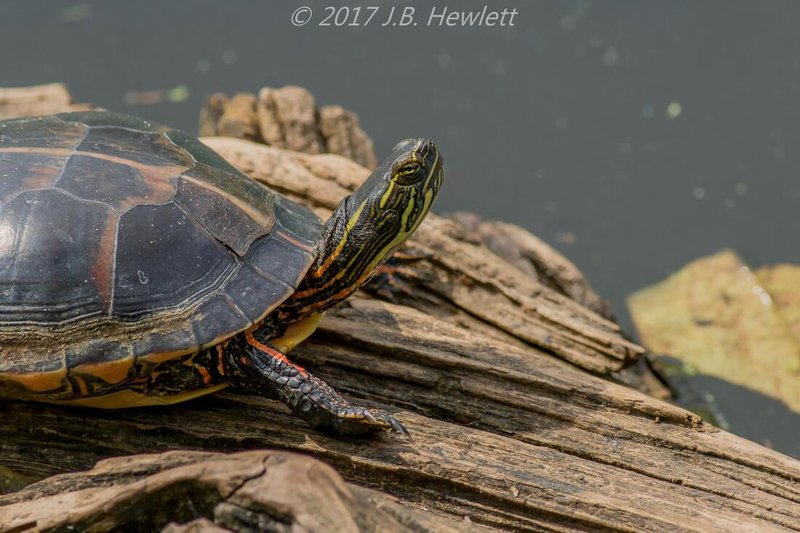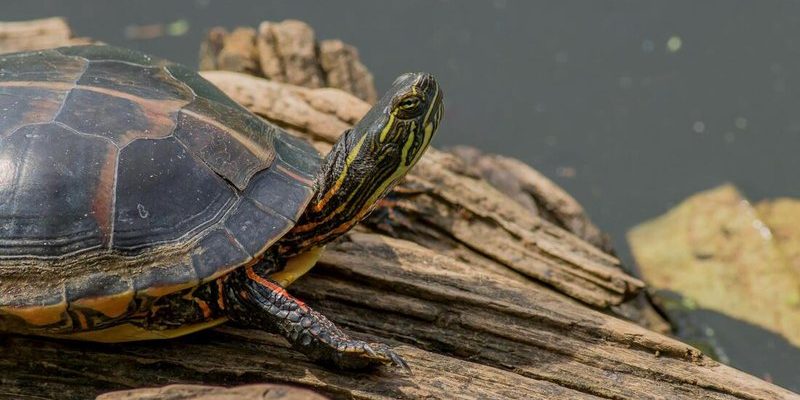
So, grab a comfy chair, pour yourself a cup of coffee, and let’s dive deep into the lesser-known facts about the painted turtle. You might just find yourself falling a little in love with these scaly wonders!
1. Stunning Shell Patterns
Let’s start with the shell, which is like the painted turtle’s signature outfit. The outer part, called the carapace, is usually a mix of dark greens or browns, adorned with bright yellow or red markings. Think of it as nature’s very own artwork. It’s not just for show, either; the patterns help them blend into their environment, making it harder for predators to spot them.
Interestingly, no two painted turtles have exactly the same markings. It’s similar to how each fingerprint is unique to a person. This individuality not only adds to their charm but also allows researchers to track their populations more effectively in the wild.
2. Habitat Preferences
You might be wondering where to find these colorful creatures. Painted turtles are quite sociable and often share their habitats with other species. They love freshwater ponds, marshes, and lakes. You can often spot them sunbathing on rocks or logs during the warmer months, soaking up the sun’s rays to help regulate their body temperature.
These turtles thrive in diverse environments, from urban parks to remote wetlands. However, they are sensitive to pollution and water quality, which is why preserving their habitats is crucial. When you see a painted turtle, you’re witnessing a little piece of nature’s balance.
3. Unique Diet and Eating Habits
What do painted turtles munch on? Their diet is quite varied, but they are primarily omnivores. They enjoy a mix of aquatic plants, insects, and small fish. Picture a little turtle nibbling on water lilies or munching on a juicy worm—it’s a sight that brings a smile.
Here’s the thing: they don’t eat just anything floating around. They’re quite selective and often forage in the shallows where they can find the freshest bites. If you ever catch a painted turtle underwater, you might notice them grazing along the bottom, showcasing their adaptability.
4. Temperature-Dependent Sex Determination
You might think that turtle sex is pretty straightforward, but here’s a twist: painted turtles have temperature-dependent sex determination. This means that the temperature of their eggs during incubation influences whether they hatch as males or females. Warmer temperatures typically produce females, while cooler temperatures create males.
Isn’t that wild? It’s nature’s way of balancing out the sexes based on environmental conditions. So, when the climate shifts, it can have a big impact on future generations of painted turtles.
5. Lifespan and Longevity
If you’ve ever thought about how long these turtles live, prepare to be amazed. Painted turtles can live to be around 30 years old in the wild, but some individuals have been known to reach ages of 50 or more in captivity. It’s similar to having a reliable old friend that you can count on for decades.
Their longevity is partly due to their ability to hide from predators and their generally low-stress lifestyle. In protected environments, they tend to flourish, showcasing the resilience of these creatures despite the challenges they face in the wild.
6. Social Creatures
You might think of turtles as solitary animals, but painted turtles are surprisingly social. They often gather in groups, especially when basking in the sun. Imagine a mini turtle party, with everyone lounging around and soaking in the warmth!
These gatherings aren’t just for fun; they help maintain their body temperature and allow them to communicate through body language. If you observe closely, you might see them nudging each other or engaging in playful interactions—a reminder that there’s more going on than meets the eye with these shell-dwelling buddies.
7. Preservation Concerns
Despite their resilience, painted turtles face challenges in their natural habitats. Urbanization, pollution, and habitat destruction put pressure on their populations. When you see one of these turtles, it’s essential to appreciate their beauty but also to think about how we can help protect their homes.
Conservation efforts are critical. Organizations work hard to preserve wetlands and educate the public about the importance of these turtles in our ecosystem. Participating in local conservation initiatives can make a difference!
8. Fun Facts About Their Behavior
Let’s wrap things up with some fun tidbits. Painted turtles are known for their quirky behaviors. For instance, did you know that they can hold their breath for up to 30 minutes while diving? It’s a cool survival tactic that allows them to evade predators.
Also, painted turtles are known to communicate through a range of sounds, from hisses to soft grunts, especially when they’re in distress. Who knew turtles had such vocal personalities? You might even catch them having a chat with each other while basking!
As we wrap up our journey through the vibrant life of the painted turtle, it’s clear they’re more than just shells and water. They have unique lifestyles, fascinating behaviors, and a critical role in their ecosystems. The next time you spot one, take a moment to appreciate the stories they hold and the colorful adventures they live. Protecting their habitats ensures that these little artists continue to inspire awe for generations to come.

